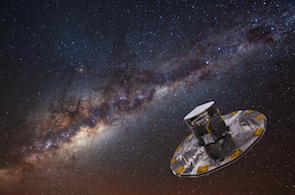Gaia science alerts are back
7 March 2016
While scanning the sky to measure the position and velocity of a billion stars, ESA's Gaia satellite also records many 'guest stars' – astronomical sources that, for a short period of time, are much brighter than usual.
 |
| Artist's impression of Gaia. Credit: ESA/ATG medialab; background image: ESO/S. Brunier |
Some of these transient objects are stars undergoing major outburst events that suddenly boost their brightness, while others are supernovae, the powerful explosions at the end of a star's life. Among these detections, it is also possible to find entire galaxies, which might occasionally become brighter due to bursts of light caused by the accreting activity of the supermassive black holes at their core.
To further understand the physical properties of these transient sources, it is crucial to observe them for a longer period of time after the first detection. For this reason, the Gaia Data Processing and Analysis Consortium (DPAC) includes a team of scientists that are responsible of scrutinising the data daily to look for unusual sources.
Whenever they identify a transient object, the Gaia Science Alert Team, based at the Institute of Astronomy in Cambridge, UK, announces the detection to the astronomical community so that other scientists can follow up on the source with other telescopes, on Earth and in space.
The team started to issue science alerts in September 2014, shortly after the beginning of the mission's routine scientific operations.
However, the Science Alert Team was very soon overwhelmed with the number of potential transient sources, up to a million per day, which had to be heavily filtered to distinguish real guest stars from contaminants in the data stream.
This data overload was due to the fact that, at the time, scientists in DPAC were still getting themselves acquainted with the complex nature of the observations performed by Gaia and the huge amount of information they contain.
So, after about ten months and almost three hundred science alerts issued, publication of the alerts was paused for six months, in the second half of 2015. During this time, the Science Alert Team implemented a number of upgrades in the filtering and detection algorithms that are used to find transients. Eventually, the improved pipeline was switched on again in January 2016.
The new filtering algorithm is now tuned to mask out very dense regions of the sky, especially towards the most crowded areas along the plane of our Galaxy, the Milky Way, where the false alarm rate is still too high. By combining this mask with an improved treatment of the Gaia data, the team managed to reduce the rate of potential transients from almost one million to a few hundreds per day.
It still takes a lot of human work to identify the actual transient – about four per day – in the total number of candidate sources, but it is definitely more manageable.
From mid-January to the end of February, the team identified a total of 175 transients and issued science alerts for the community. Most of the sources are supernova candidates and binary stellar systems known as cataclysmic variables, but a number of exotic stellar sources were also found.
The team is looking forward to further improving the detection algorithms, and predictions suggest they might eventually find about ten transients per day. Many of these sources are being followed up on by observational programmes in both the northern and southern hemispheres.
Contacts
Timo Prusti
Gaia Project Scientist
European Space Agency
Email: timo.prusti![]() esa.int
esa.int
Simon Hodgkin
Gaia Science Alert Team
Institute of Astronomy
Cambridge, UK
Email: sth![]() ast.cam.ac.uk
ast.cam.ac.uk

